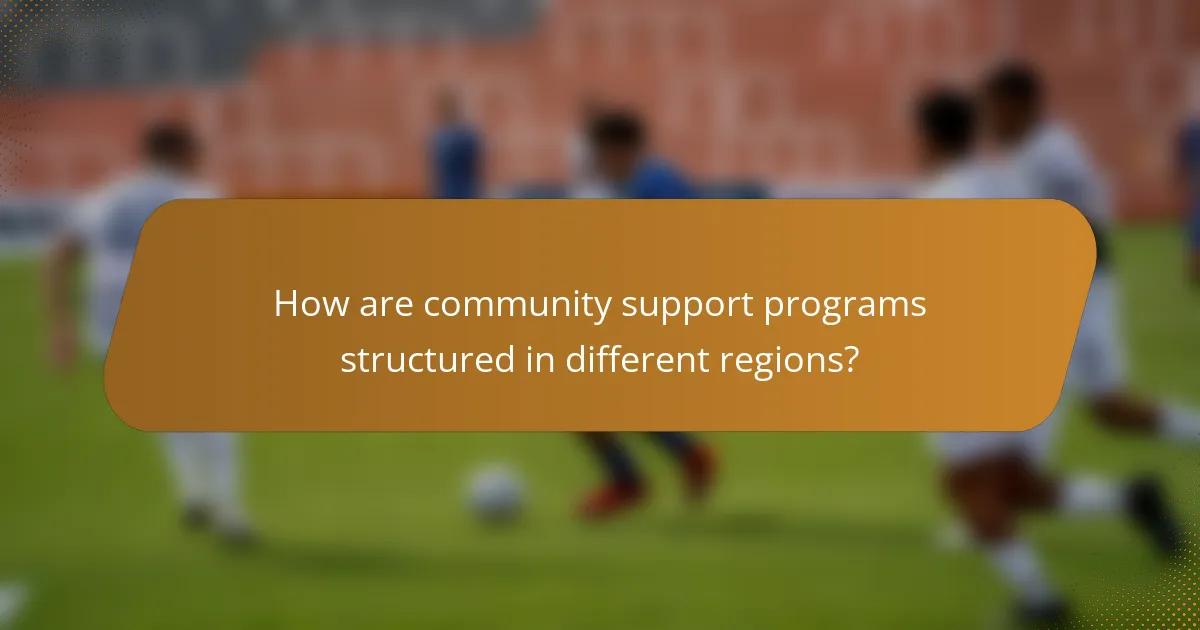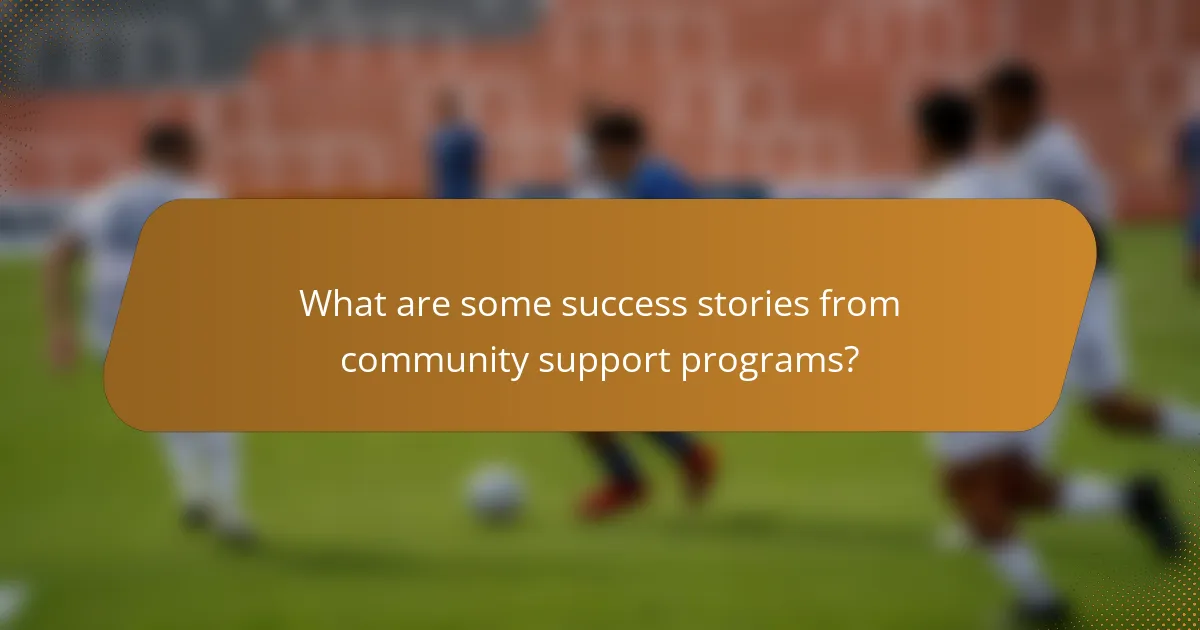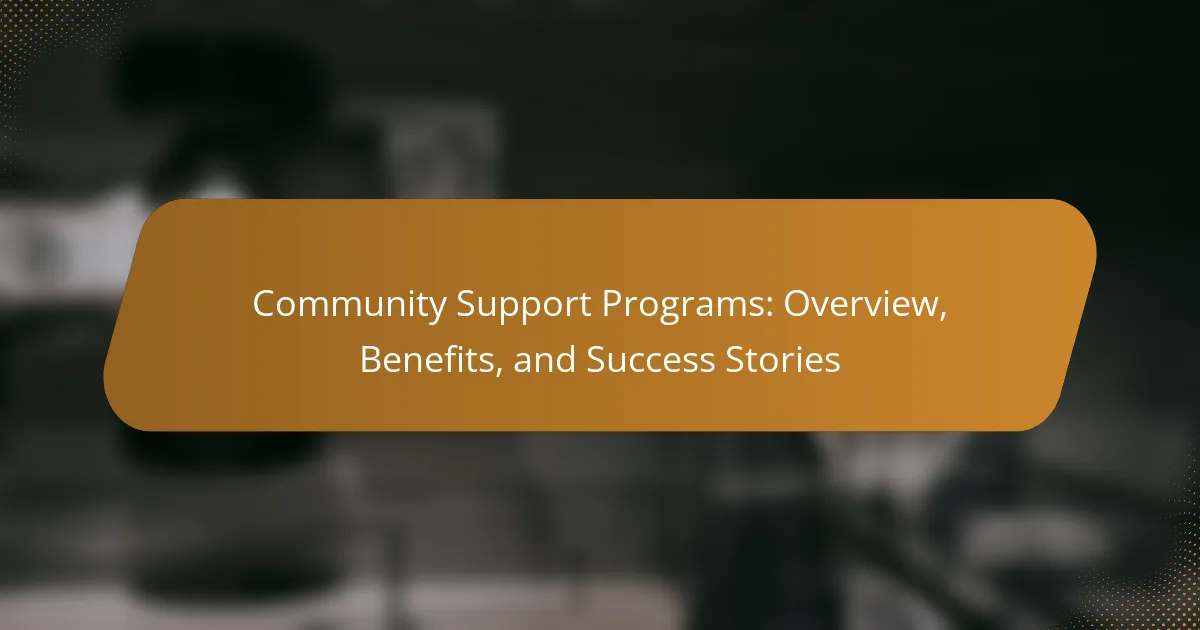Community support programs enhance well-being by fostering social connections and providing essential resources. They offer outreach services, promote community engagement, and evaluate their effectiveness. These programs vary by region, addressing local needs through tailored initiatives. Success stories illustrate their positive impact on individuals and communities, showcasing how they can transform lives and strengthen resilience.

What are the key components of community support programs?
Community support programs consist of several key components that enhance their effectiveness. These components include outreach services, resource coordination, community engagement, and evaluation metrics. Outreach services connect individuals with necessary support, while resource coordination ensures access to essential services. Community engagement fosters participation and collaboration among members, and evaluation metrics assess the program’s impact and success. Together, these elements create a robust framework for supporting community needs.
How do community support programs address local needs?
Community support programs effectively address local needs by fostering collaboration, enhancing resource accessibility, and promoting community engagement. They identify specific challenges within communities, such as food insecurity or lack of healthcare access, and implement targeted initiatives. These programs often rely on local partnerships to mobilize resources and deliver tailored solutions. For instance, a program might provide food banks and health screenings, directly responding to pressing community concerns.
Which organizations typically implement these programs?
Various organizations implement community support programs, including non-profits, local governments, and educational institutions. Non-profit organizations often focus on specific community needs, providing resources and services. Local governments may initiate programs to enhance social welfare and community cohesion. Educational institutions can also play a role by offering support services to students and families. Additionally, faith-based organizations frequently engage in community support through outreach initiatives.
What roles do volunteers play in community support programs?
Volunteers play essential roles in community support programs by providing manpower, skills, and resources. They help organize events, distribute food, and offer emotional support to those in need. Volunteers also foster community engagement, promoting social cohesion and awareness of local issues. Their contributions significantly enhance the effectiveness and reach of these programs, leading to improved outcomes for individuals and families.

What benefits do community support programs provide?
Community support programs provide numerous benefits, including enhanced social connections, improved mental health, and increased access to resources. They foster community engagement and promote a sense of belonging. Programs often offer educational opportunities, skill development, and support networks that empower individuals. As a result, these initiatives can lead to stronger, more resilient communities.
How do these programs improve social cohesion?
Community support programs enhance social cohesion by fostering connections among individuals. They create shared experiences, promote collaboration, and encourage mutual support. As a result, participants develop trust and a sense of belonging. Programs often include community events, volunteer opportunities, and skill-sharing workshops, which strengthen relationships and reduce isolation. These initiatives help bridge cultural and socioeconomic divides, leading to more inclusive communities.
What impact do community support programs have on mental health?
Community support programs significantly enhance mental health by providing social connections and resources. They foster a sense of belonging, reduce isolation, and improve emotional well-being. Research shows that participants in these programs report lower levels of anxiety and depression. Success stories highlight communities where support initiatives led to increased resilience and improved mental health outcomes.
Which economic advantages are associated with community support initiatives?
Community support initiatives provide significant economic advantages, including job creation, increased local spending, and enhanced community resilience. These programs foster local entrepreneurship, leading to sustainable economic growth. For instance, community gardens not only provide food security but also create employment opportunities in urban areas. Additionally, such initiatives can attract funding and investment, bolstering local economies. As a result, communities become more self-sufficient and economically stable.

How are community support programs structured in different regions?
Community support programs vary significantly across regions, reflecting local needs and resources. In urban areas, programs often focus on mental health services and housing assistance, while rural regions may emphasize agricultural support and community engagement initiatives.
For example, in North America, community support programs frequently include food banks and job training services, addressing immediate needs and long-term economic stability. In contrast, European models may prioritize social inclusion and healthcare access, fostering community cohesion through diverse services.
Additionally, Asia’s community support initiatives often integrate cultural practices, promoting family involvement and local traditions in their frameworks. This regional diversity showcases how programs are tailored to meet specific community challenges and leverage unique local strengths.
Overall, while the core goal of community support programs remains consistent—enhancing well-being—their structure and focus adapt to the distinct attributes of each region.
What variations exist in program types across different countries?
Community support programs vary significantly across countries, reflecting cultural, economic, and social differences. For instance, some nations prioritize mental health support, while others focus on poverty alleviation.
| Country | Program Type | Key Focus Area | Unique Attribute |
|——————|—————————-|——————————|—————————–|
| United States | Nonprofit Organizations | Mental health services | Extensive volunteer network |
| Sweden | Government Initiatives | Social welfare | Universal coverage |
| Japan | Community Centers | Elderly support | Strong community involvement |
| Brazil | NGO Partnerships | Youth development | Cultural integration |
| Australia | Local Government Programs | Indigenous support | Tailored services |
| India | Grassroots Movements | Rural aid | Diverse local solutions |
How do cultural differences influence program effectiveness?
Cultural differences significantly influence program effectiveness by shaping community engagement, communication styles, and resource allocation. Programs tailored to cultural contexts foster trust and participation, enhancing overall impact. For instance, culturally relevant messaging improves outreach, while understanding local customs ensures appropriate service delivery. Programs that respect and incorporate cultural values often experience higher success rates and community support.

What are some success stories from community support programs?
Community support programs have numerous success stories that demonstrate their positive impact. For instance, a local food bank increased access to nutritious meals, serving over 10,000 families annually. Another program focused on youth mentorship reduced school dropout rates by 30% within three years. Additionally, a mental health initiative provided counseling services to 5,000 individuals, significantly improving community well-being. These examples highlight the transformative effects of community support programs in enhancing quality of life and fostering resilience.
Which community support programs have shown measurable success?
Several community support programs have demonstrated measurable success, including food assistance initiatives, mental health outreach, and youth mentorship schemes. For instance, the Supplemental Nutrition Assistance Program (SNAP) has significantly reduced food insecurity rates, while mental health programs have improved access to care for underserved populations. Youth mentorship programs have shown increased graduation rates and reduced delinquency. These programs highlight the effectiveness of targeted community support in addressing specific needs.
How do individual testimonials reflect program impact?
Individual testimonials provide qualitative evidence of the impact of community support programs. They illustrate personal experiences and highlight specific benefits, such as improved mental health, increased social connections, and enhanced community engagement. These narratives often serve as powerful endorsements, showcasing unique transformations that resonate with potential participants. Additionally, testimonials can reveal rare attributes of programs, such as tailored support that meets diverse community needs, thereby reinforcing the program’s effectiveness and relevance.

What challenges do community support programs face?
Community support programs face challenges such as funding shortages, volunteer retention, and program evaluation. Limited resources can hinder service delivery, while maintaining volunteer engagement is crucial for sustainability. Additionally, measuring impact can be complex, affecting future support and growth.
How do funding issues affect program sustainability?
Funding issues significantly hinder program sustainability by limiting resources, reducing staff, and impairing service delivery. Insufficient funding leads to program cuts, diminished outreach, and decreased community impact. Programs that rely on grants may face instability due to fluctuating funding cycles. As a result, consistent financial support is crucial for maintaining effective community support initiatives.
What barriers to participation exist for community members?
Barriers to participation for community members include lack of awareness, limited accessibility, and insufficient resources. These factors hinder engagement in community support programs. For example, individuals may not know about available programs, face physical barriers to access, or lack transportation options. Addressing these barriers can enhance participation and improve program effectiveness.

What unique attributes distinguish successful community support programs?
Successful community support programs are distinguished by their tailored approaches, strong local partnerships, and ongoing evaluation mechanisms. These unique attributes enable them to effectively address specific community needs and adapt to changing circumstances. Tailored approaches ensure programs are relevant to the target population, while strong local partnerships enhance resource sharing and community engagement. Ongoing evaluation mechanisms allow for continuous improvement and accountability, fostering trust and support within the community.
How do innovative approaches enhance program reach?
Innovative approaches significantly enhance program reach by leveraging technology, community engagement, and tailored strategies. For example, digital platforms expand accessibility, allowing programs to connect with diverse populations. Community partnerships increase resource sharing and local knowledge, fostering trust and participation. Data-driven insights enable targeted outreach, ensuring programs address specific needs effectively.
What role does technology play in modern community support initiatives?
Technology enhances community support initiatives by improving communication, resource sharing, and data management. Digital platforms facilitate collaboration among organizations, enabling them to reach more individuals in need. For instance, social media campaigns raise awareness and mobilize volunteers effectively. Additionally, data analytics help identify community needs, allowing for targeted interventions. These advancements foster stronger connections and more efficient support systems, ultimately benefiting the entire community.

What best practices can enhance the effectiveness of community support programs?
To enhance the effectiveness of community support programs, focus on collaboration, clear communication, and measurable outcomes. Engaging local stakeholders ensures programs meet actual needs. Regular feedback loops improve services and build trust. Training volunteers enhances program delivery, while data-driven approaches track progress and inform adjustments.
How can organizations measure the success of their programs?
Organizations can measure the success of their community support programs through defined metrics and feedback mechanisms. Key performance indicators include participant engagement levels, community impact assessments, and program reach. Surveys and interviews provide qualitative data on participant satisfaction and perceived benefits. Tracking funding utilization and resource allocation helps assess efficiency. Regular evaluations and adjustments based on findings ensure continuous improvement and alignment with community needs.
What strategies can be employed to increase community engagement?
To increase community engagement, implement strategies such as fostering partnerships, hosting events, and utilizing social media. These approaches create connections and encourage participation.
1. Foster partnerships with local organizations to pool resources and reach wider audiences.
2. Host community events that cater to diverse interests, promoting inclusivity and participation.
3. Utilize social media platforms to share updates, gather feedback, and create a sense of community.
4. Encourage volunteer opportunities that empower residents to contribute and feel invested.
5. Provide incentives for participation, such as recognition or rewards, to motivate community members.
Which common mistakes should be avoided in program implementation?
To ensure successful program implementation, avoid common mistakes such as inadequate community engagement, unclear objectives, insufficient training, and lack of evaluation measures. These pitfalls can hinder the effectiveness of community support programs. Engaging stakeholders early fosters ownership, while clear objectives guide actions. Training equips staff with necessary skills, and ongoing evaluation ensures continuous improvement.
